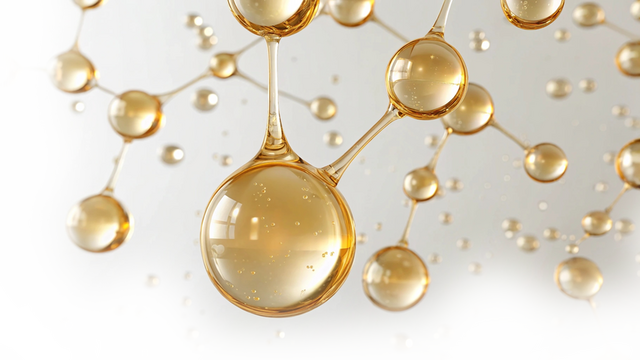
Panel discussion on...
Peptides
Emerging Trends in Peptide Use: Innovations and Applications
What are some of the most exciting innovations in peptide technology that you've seen recently?
Important recent innovations in peptide technology are related to the sustainability of synthetic peptides, more and more suitable for the current needs and expectations of consumers. Another important feature of designed peptides is their higher level of efficacy compared to other substances. Some peptides have been successfully designed to mimic endogenous ligands – such as growth factors – or target widespread acknowledged biological pathways making the correlation between claim and performance easier to perceive by the end user. Taken together, this favors a broader use of peptides in cosmetics, even beyond face care.
How can peptides differentiate themselves in the competitive, saturated anti-ageing market and what unique benefits do they offer that can appeal to modern skincare consumers?
If properly designed, peptides can be very powerful in terms of efficacy, hence representing a tiny fraction of a formulation – sometimes less than 1% of the bill. Since skin processes are complex, for a said application – antiaging, for example – it is possible to create solutions with peptides that include collagen production for skin firmness, adipogenesis for lipofilling, and reduce muscular contraction to attenuate wrinkles. With peptides, a formulator can envision more attractive products for the consumer like never before.
Do you foresee peptides expanding beyond ageing care with the skinification trend?
No question about it. Anti-ageing will always be important in this industry, but there are peptides being developed for other cosmetic applications as well – some of them as a new approach for conditions with scarce reliable alternatives. For example, most skin oiliness control active ingredients target 5α-reductase, frequently with low performance levels; a novel peptide for skin oiliness control targeting melanocortin 5 receptor was recently made available. This peptide can be used not only for sebogenesis control as a primary claim for a product but also as adjuvant for other applications, such as makeup and sunscreens (1).
Mechanisms of Action of Peptide and Market Perception
Can you explain how peptides function at the cellular level to promote skin health?
Peptides can strongly interact with structures like proteins (receptors and enzymes, for example) in a very specific way to either activate or deactivate cellular processes, triggering or blocking a cascade of events that will ultimately lead to a desired cellular behavior. Some peptides do not even need to permeate cells, as their target is located at the cell membrane, such as ion channels or membrane receptors. While these interactions can be very strong, small peptides used in cosmetics do not chemically change their biological target – which is very interesting from a safety perspective.
Which specific skin concerns, like ageing (morphological and dyschromic), are most effectively addressed by peptides, and why?
Due to the nature of the interactions between the biological target and the endogenous ligand, peptides could be considered a good first choice for any conditions that can be somehow modulated by proteinogenic signaling substances. For example, reducing skin oiliness, addressing dynamic wrinkles, and controlling melanin production by means of peptide topic administration are good examples with proven efficacy.
There’s a lot of hype around peptides. What are some common myths or misconceptions that you'd like to clarify for both formulators and consumers?
While peptides usually are the result of a lot of science, research and technology, they are not exactly expensive; if properly designed, a peptide is used in tiny amounts in a formulation – parts per million – so the cost in use of peptides matches that of most current cosmetic active ingredients. Also, peptides are just another class of substances and should be treated as such – meaning that they are not less stable than other active ingredients and they have their own behavior.
What are the key differences between natural and synthetic peptides in terms of efficacy and safety?
The main difference between natural and synthetic peptides lies in their source and purity. For a single peptide where the active molecule itself is the same, efficacy and safety should be the same. However, natural peptides are extracted from biological sources; structural variations and impurities such as endotoxins and allergens and fragments that carry immunogenic potential depending on the source and reproducibility from batch to batch may be some of the issues. In contrast, the molecular design of synthetic peptides allows for optimization of the desired sequence for greater stability and bioactivity and removal of any unwanted immunogenic sequences from the product; since they are produced through controlled conditions, batch reproducibility is easily reached and synthetic peptides are usually made available in a very pure form, so higher safety and efficacy can be expected. That said, both safety and efficacy may be assessed in all cases and the choice between natural or synthetic peptides depends on the intended application and regulatory requirements.
Formulation Challenges and Solutions
What are some of the biggest challenges when formulating with peptides, particularly in ensuring stability and efficacy? / What are the primary technical hurdles in formulating stable, active peptide products, and how have recent innovations addressed these?
Just like any active ingredient, chemical compatibility should be assessed beforehand. In terms of stability, pH plays an important role; N-acylation and/or encapsulation also tend to protect peptides from degradation, inactivation or other undesired behavior but these are not intrinsically mandatory.
How do peptides interact/behave with other active ingredients in complex formulations?
Just like any substance, peptides may interact positively or negatively with other active ingredients in a complex formulation. Also, a deep understanding of the biological mechanisms of all ingredients in said formulation is important when designing high performance formulations. With the proper formulation, peptides may deliver unmatched performance if combined with synergic actives.
Sustainability and Peptides
Sustainability is a growing concern in the cosmetics industry. How are peptide manufacturers addressing this issue?
A lot of research is going on to make peptide products greener and we already have synthetic peptides that are close to 100% green, with minimal waste production. Hazardous reagents traditionally used in peptide synthesis, such as piperidine, have been replaced by safer alternatives. There are also other approaches being used to increase sustainability, such as upscaling to more environmentally friendly processes and upcycling. The latter is particularly interesting as addresses several concerns related to industrial production, such as waste generation and landfill disposal of biomass residue.
What are the environmental trade-offs between sourcing natural peptides from marine or agricultural sources and synthesising them in labs?
Sourcing from natural sources may require a lot of space that could be used for more urgent matters such as food production; it may also have an impact on local fauna and flora. Natural peptides may seem green at first glance, but in order to obtain an active fraction they may require the use of big amounts of solvents and energy; they also generate a huge amount of waste. Opposed to this, synthetic peptides require minimal space, their production processes may be designed to fulfill green chemistry principles, such as atom economy (which prevents pollution at a molecular level), catalysis and use of renewable feedstocks. Taken together, all of these make synthetic peptides the most sustainable option with the recent advances.
Panelists
References and notes
- Katekawa E, Arruda Brasil MCO, Princival CR, Padovani G, Esteves-Pedro NM, Mussi L, et al. (2024) Effect of Tripeptide-85 (EVF) on Sebogenesis. Clin Exp Dermatol Ther 9: 223. https://doi.org/10.29011/2575-8268.100223




































